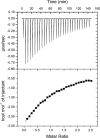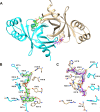Molecular insights into the binding of coenzyme F420 to the conserved protein Rv1155 from Mycobacterium tuberculosis
- PMID: 25644473
- PMCID: PMC4420522
- DOI: 10.1002/pro.2645
Molecular insights into the binding of coenzyme F420 to the conserved protein Rv1155 from Mycobacterium tuberculosis
Abstract
Coenzyme F420 is a deazaflavin hydride carrier with a lower reduction potential than most flavins. In Mycobacterium tuberculosis (Mtb), F420 plays an important role in activating PA-824, an antituberculosis drug currently used in clinical trials. Although F420 is important to Mtb redox metabolism, little is known about the enzymes that bind F420 and the reactions that they catalyze. We have identified a novel F420 -binding protein, Rv1155, which is annotated in the Mtb genome sequence as a putative flavin mononucleotide (FMN)-binding protein. Using biophysical techniques, we have demonstrated that instead of binding FMN or other flavins, Rv1155 binds coenzyme F420 . The crystal structure of the complex of Rv1155 and F420 reveals one F420 molecule bound to each monomer of the Rv1155 dimer. Structural, biophysical, and bioinformatic analyses of the Rv1155-F420 complex provide clues about its role in the bacterium.
Keywords: Mycobacterium tuberculosis; Rv1155; coenzyme F420; conserved hypothetical protein.
© 2015 The Protein Society.
Figures







Similar articles
-
Crystal structure of the conserved hypothetical protein Rv1155 from Mycobacterium tuberculosis.FEBS Lett. 2005 Jan 3;579(1):215-21. doi: 10.1016/j.febslet.2004.11.069. FEBS Lett. 2005. PMID: 15620716
-
Structures of Mycobacterium tuberculosispyridoxine 5'-phosphate oxidase and its complexes with flavin mononucleotide and pyridoxal 5'-phosphate.Acta Crystallogr D Biol Crystallogr. 2005 Nov;61(Pt 11):1492-9. doi: 10.1107/S0907444905026673. Epub 2005 Oct 19. Acta Crystallogr D Biol Crystallogr. 2005. PMID: 16239726
-
Discovery and characterization of an F420-dependent glucose-6-phosphate dehydrogenase (Rh-FGD1) from Rhodococcus jostii RHA1.Appl Microbiol Biotechnol. 2017 Apr;101(7):2831-2842. doi: 10.1007/s00253-016-8038-y. Epub 2016 Dec 13. Appl Microbiol Biotechnol. 2017. PMID: 27966048 Free PMC article.
-
Physiology, Biochemistry, and Applications of F420- and Fo-Dependent Redox Reactions.Microbiol Mol Biol Rev. 2016 Apr 27;80(2):451-93. doi: 10.1128/MMBR.00070-15. Print 2016 Jun. Microbiol Mol Biol Rev. 2016. PMID: 27122598 Free PMC article. Review.
-
Flavogenomics--a genomic and structural view of flavin-dependent proteins.FEBS J. 2011 Aug;278(15):2625-34. doi: 10.1111/j.1742-4658.2011.08202.x. Epub 2011 Jul 5. FEBS J. 2011. PMID: 21635694 Review.
Cited by
-
Cofactor F420: an expanded view of its distribution, biosynthesis and roles in bacteria and archaea.FEMS Microbiol Rev. 2021 Sep 8;45(5):fuab021. doi: 10.1093/femsre/fuab021. FEMS Microbiol Rev. 2021. PMID: 33851978 Free PMC article.
-
Recombinant Aflatoxin-Degrading F420H2-Dependent Reductase from Mycobacterium smegmatis Protects Mammalian Cells from Aflatoxin Toxicity.Toxins (Basel). 2019 May 8;11(5):259. doi: 10.3390/toxins11050259. Toxins (Basel). 2019. PMID: 31072027 Free PMC article.
-
Rv2074 is a novel F420 H2 -dependent biliverdin reductase in Mycobacterium tuberculosis.Protein Sci. 2016 Sep;25(9):1692-709. doi: 10.1002/pro.2975. Epub 2016 Jul 17. Protein Sci. 2016. PMID: 27364382 Free PMC article.
-
FAD-sequestering proteins protect mycobacteria against hypoxic and oxidative stress.J Biol Chem. 2019 Feb 22;294(8):2903-2912. doi: 10.1074/jbc.RA118.006237. Epub 2018 Dec 19. J Biol Chem. 2019. PMID: 30567740 Free PMC article.
-
Cofactor Tail Length Modulates Catalysis of Bacterial F420-Dependent Oxidoreductases.Front Microbiol. 2017 Sep 27;8:1902. doi: 10.3389/fmicb.2017.01902. eCollection 2017. Front Microbiol. 2017. PMID: 29021791 Free PMC article.
References
-
- Koul A, Arnoult E, Lounis N, Guillemont J, Andries K. The challenge of new drug discovery for tuberculosis. Nature. 2011;469:483–490. - PubMed
-
- Raviglione M, Marais B, Floyd K, Lonnroth K, Getahun H, Migliori GB, Harries AD, Nunn P, Lienhardt C, Graham S, Chakaya J, Weyer K, Cole S, Kaufmann SH, Zumla A. Scaling up interventions to achieve global tuberculosis control: progress and new developments. Lancet. 2012;379:1902–1913. - PubMed
-
- Barry CE, III, Boshoff HI, Dowd CS. Prospects for clinical introduction of nitroimidazole antibiotics for the treatment of tuberculosis. Curr Pharm Des. 2004;10:3239–3262. - PubMed
-
- Bair TB, Isabelle DW, Daniels L. Structures of coenzyme F420 in Mycobacterium species. Arch Microbiol. 2001;176:37–43. - PubMed
Publication types
MeSH terms
Substances
Grants and funding
LinkOut - more resources
Full Text Sources
Other Literature Sources
Molecular Biology Databases

